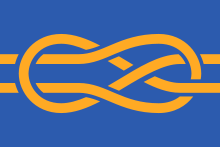
Nordic Flag Society
Encyclopedia

Nordic countries
The Nordic countries make up a region in Northern Europe and the North Atlantic which consists of Denmark, Finland, Iceland, Norway and Sweden and their associated territories, the Faroe Islands, Greenland and Åland...
vexillologists. It has an official name in the languages of all the five countries in which its activities are principally based: Nordiska Flaggsällskapet (Swedish), Nordisk Flagselskab (Danish), Nordisk Flaggselskap (Norwegian), Pohjoismaiden Lippuseura (Finnish), and Norræna Fánafélagið (Icelandic). Founded in Copenhagen on 27. January 1973, the Nordic Flag Society is dedicated to the study of flags and promotion of vexillology in Scandinavia.
The Nordic Flag Society is a member of the Fédération internationale des associations vexillologiques
Fédération internationale des associations vexillologiques
The Fédération internationale des associations vexillologiques is an international federation of 55 regional, national, and multinational associations and institutions across the globe that study vexillology, which FIAV defines in its constitution as "the creation and development of a body of...
(FIAV). In 2003 the Nordic Flag Society hosted the XX. International Congress of Vexillology with Stockholm as the venue.
The Nordic Flag Society has its own flag, a Nordic cross flag
Nordic Cross Flag
The Nordic Cross Flag, Nordic Cross, or Scandinavian Cross is a pattern of flags usually associated with the flags of the Scandinavian countries of which it originated. All of the Nordic countries except Greenland have adopted such flags...
with a fimbrated red cross on a yellow field. The arms of the cross meet to form a knot similar to that on the flag of the Fédération internationale des associations vexillologiques.


